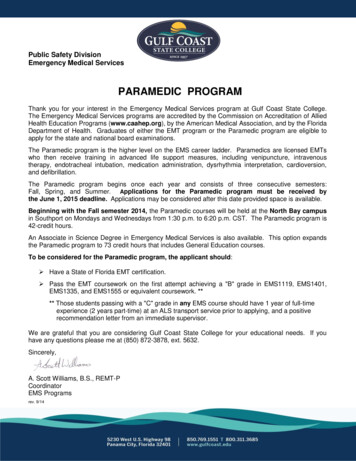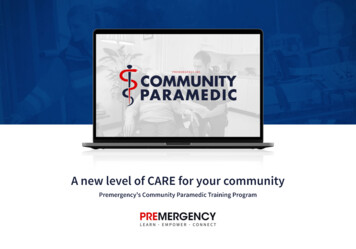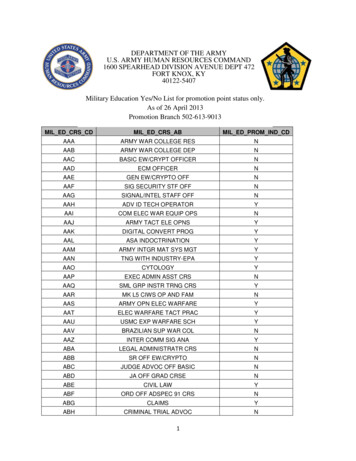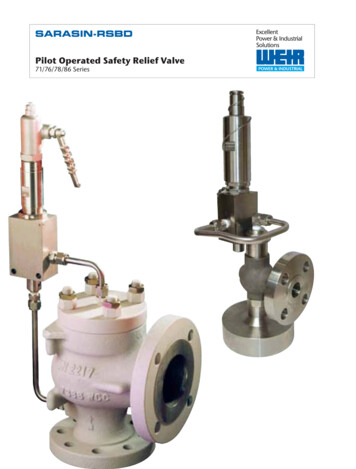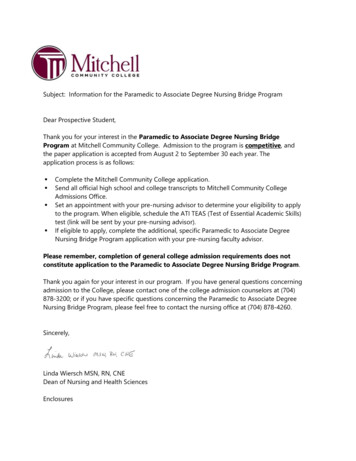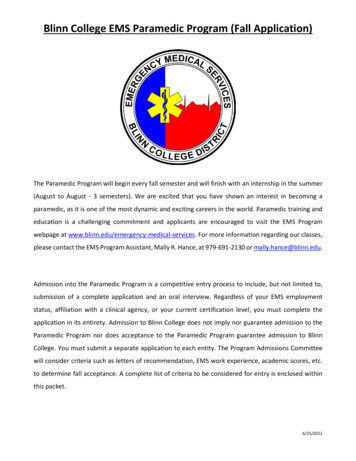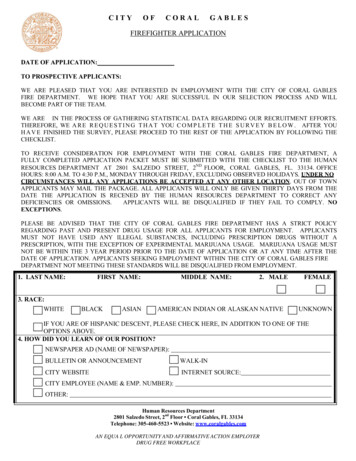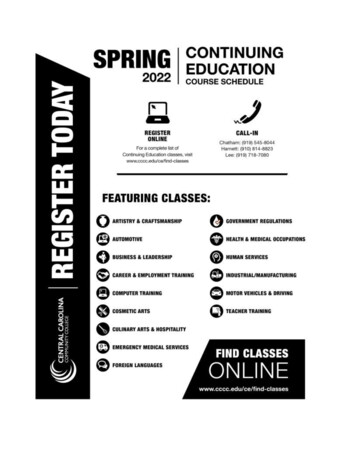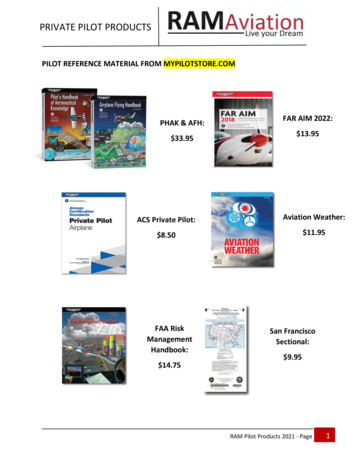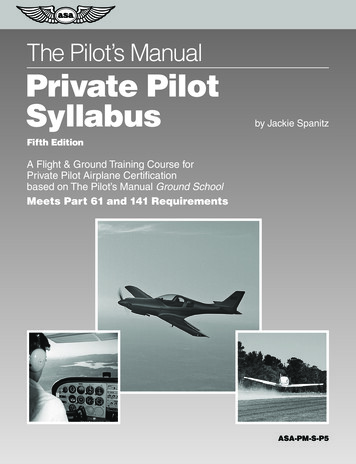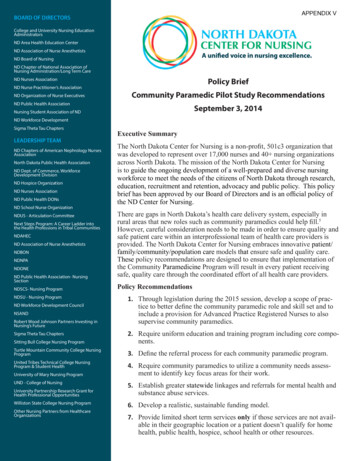
Transcription
APPENDIX VBOARD OF DIRECTORSCollege and University Nursing EducationAdministratorsND Area Health Education CenterND Association of Nurse AnesthetistsND Board of NursingND Chapter of National Association ofNursing Administration/Long Term CarePolicy BriefND Nurses AssociationND Nurse Practitioner’s AssociationND Organization of Nurse ExecutivesCommunity Paramedic Pilot Study RecommendationsND Public Health AssociationSeptember 3, 2014Nursing Student Association of NDND Workforce DevelopmentSigma Theta Tau ChaptersLEADERSHIP TEAMND Chapters of American Nephrology NursesAssociationNorth Dakota Public Health AssociationND Dept. of Commerce, WorkforceDevelopment DivisionND Hospice OrganizationND Nurses AssociationND Public Health DONsND School Nurse OrganizationNDUS - Articulation CommitteeNext Steps Program: A Career Ladder intothe Health Professions in Tribal CommunitiesNDAHECND Association of Nurse AnesthetistsNDBONNDNPANDONEND Public Health Association- NursingSectionNDSCS- Nursing ProgramNDSU - Nursing ProgramND Workforce Development CouncilNSANDRobert Wood Johnson Partners Investing inNursing’s FutureExecutive SummaryThe North Dakota Center for Nursing is a non-profit, 501c3 organization thatwas developed to represent over 17,000 nurses and 40 nursing organizationsacross North Dakota. The mission of the North Dakota Center for Nursingis to guide the ongoing development of a well-prepared and diverse nursingworkforce to meet the needs of the citizens of North Dakota through research,education, recruitment and retention, advocacy and public policy. This policybrief has been approved by our Board of Directors and is an official policy ofthe ND Center for Nursing.There are gaps in North Dakota’s health care delivery system, especially inrural areas that new roles such as community paramedics could help fill.5However, careful consideration needs to be made in order to ensure quality andsafe patient care within an interprofessional team of health care providers isprovided. The North Dakota Center for Nursing embraces innovative patient/family/community/population care models that ensure safe and quality care.These policy recommendations are designed to ensure that implementation ofthe Community Paramedicine Program will result in every patient receivingsafe, quality care through the coordinated effort of all health care providers.Policy Recommendations1. Through legislation during the 2015 session, develop a scope of practice to better define the community paramedic role and skill set and toinclude a provision for Advanced Practice Registered Nurses to alsosupervise community paramedics.Sitting Bull College Nursing Program2. Require uniform education and training program including core components.Turtle Mountain Community College NursingProgram3. Define the referral process for each community paramedic program.United Tribes Technical College NursingProgram & Student Health4. Require community paramedics to utilize a community needs assessment to identify key focus areas for their work.Sigma Theta Tau ChaptersUniversity of Mary Nursing ProgramUND - College of NursingUniversity Partnership Research Grant forHealth Professional OpportunitiesWilliston State College Nursing ProgramOther Nursing Partners from HealthcareOrganizations5. Establish greater statewide linkages and referrals for mental health andsubstance abuse services.6. Develop a realistic, sustainable funding model.7. Provide limited short term services only if those services are not available in their geographic location or a patient doesn’t qualify for homehealth, public health, hospice, school health or other resources.
8. Establish limited and short term/ emergent interventions paired with appropriate community paramedictraining.9. Through legislation during the 2015 session, include provider-neutral language in order to ensure that Advanced Practice Registered Nurses are able to supervise/delegate to community paramedics.10. Through legislation during the 2015 session, provide clear definition and reporting lines for accountabilityand mechanism for documentation of care including provider orders.11. Establish a standardized approach across jurisdictions that facilitates statewide program evaluation using nationalguidelines for evaluation.12. Require additional ongoing training reflecting the changing needs of the community or evolving health issues.IntroductionThe North Dakota Center for Nursing is a non-profit, 501c3 organization that was developed to represent over17,000 nurses and 40 nursing organizations across North Dakota. The mission of the North Dakota Center forNursing is to guide the ongoing development of a well-prepared and diverse nursing workforce to meet the needsof the citizens of North Dakota through research, education, recruitment and retention, advocacy and public policy.This policy brief has been approved by our Board of Directors and is an official policy of the ND Center for Nursing.The North Dakota Center for Nursing embraces innovative models to ensure safe and quality care. Every patientdeserves access to safe, quality care from all healthcare providers. Health care delivery is ever-changing and is currently undergoing a significant transformation due to changes in the population and implementation of the Affordable Care Act. The North Dakota Center for Nursing supports initiatives which allow all members of the healthcareteam to fully function consistent with their education and scope of practice as interprofessional partners.Patient centered care coordination is a foundational element of nursing practice and is at the heart of nursing practice which makes nursing an integral partner of the health care team. The Institute of Medicine in 20031 emphasized the impact of coordination of care on improving the quality of care. In the Institute of Medicine 2011 report,this care coordination was cited as one of the traditional strengths of the nursing profession whether in the community or in the acute care setting2.The Community Paramedicine Program has the potential to operationalize the Institute for Healthcare Improvement Triple Aim3 of decreasing healthcare costs, improving health outcomes and improving patient experiences.These outcomes should serve as the basis for program evaluation and provide the definition of success.Certainly there are gaps in North Dakota’s health care delivery system, especially in rural areas that new rolessuch as community paramedics could help fill.5 However, careful consideration needs to be made in order to ensurequality and safe patient care within an interprofessional team of health care providers is provided. The NationalConsensus Conference on Community Paramedicine funded by the Agency for Healthcare Research and Quality(2012) explored the incorporation of community paramedics within the interdisciplinary health workforce environment. The study indicated that as standards of care and protocols evolve with increasingly interdependent roles between community paramedic providers and others in the healthcare system, it is necessary to determine the specificaspects of care for which community paramedic providers will be held accountable. The study recommended thatsuccessful integration of community paramedics will involve fulfilling six Cs4: Community: addressing a current unfulfilled need; Complementary: enhancement without duplication; Collaborative: interdisciplinary practice; Competence: qualified practitioners ; Compassion: respect for individuals; Credentialed: legal authorization to function.Our policy recommendations are designed to help fulfill these and to help ensure that quality care is provided withno duplication of services to the citizens of North Dakota.
Policy Recommendations1. Through legislation during the 2015 session, develop a scope of practice to better define the community paramedic role and skill set and to include a provision for Advanced Practice Registered Nursesto also supervise community paramedics. The current scope of practice (Century Code 33-36-04-02)6for a paramedic is focused on the provision of acute care and an interface with the hospital rather than thecommunity setting. The Western Eagle County Health Services District in Colorado7 indicated that it willbe important to develop policies and procedures that provide explicit boundaries around the program.2. Require uniform education and training program including core components. Uniform education andclinical training from an accredited program in the higher education setting consistent with the functionsof the community paramedic role, should be required by state statue.8 The American Nurses Associationrecommends that accredited educational programs should include core components from social and behavioral sciences and social determinants such as:1. Cultural competency;2. Community roles and resources;3. Health Assessment;4. Personal Safety;5. Professional Boundaries6. Clinical components that include sub-acute and semi-chronic patient needsThe educational program should also include components on interprofessional role development such asrole clarification, patient/client/family/ community centered care, team functioning, collaborative leadership, interprofessional communication and dealing with interprofessional conflict.9 Currently, the pilot program has been utilizing the Hennepin Technical College Community Paramedic Program. It is not knownwhether this program includes all of the core components listed above.3. Define the referral process for each community paramedic program. This includes how orders aretransmitted between providers, the procedure for connecting patients with community paramedics, referringpatients to other services and refusing care. Effective referral is important in maintaining continuity of careand are especially important for coordinating care between settings such as a hospital and a community.8,104. Require community paramedics to utilize a community needs assessment to identify key focus areas for their work. Community paramedics should utilize existing resources. The Western Eagle CountyHealth Services District in Colorado7 indicated that the community needs assessment can determine: The leading causes of preventable morbidity and mortality; Gaps in health care services; Demographics of the populations most impacted by the gaps; Characteristics of those who most frequently use the ambulance service; Most frequent conditions requiring hospital admission; The greatest health care needs as seen by local medical providers;Local public health units are experienced in conducting these assessments. All hospitals including CriticalAccess Hospitals have also conducted community needs assessments. The assessment would be used tocustomize the scope of the program to the needs of that community. Prior to implementation communityparamedics should meet with key community partners including health care agencies, home health, publichealth, hospice and school health in each community in order to ensure coordination and no duplication ofservices. A written resource guide which includes available resources should be available for the community paramedic.
5. Establish greater linkage and referral statewide for mental health and substance abuse services.According to testimony by F-M Ambulance Service,15 the primary reasons an ambulance is called for thetop ten frequent users in the Fargo/Moorhead area are mental health issues (50%), diabetes complications(20%), seizures (20%) and substance abuse (10%). Greater linkage and referral is needed statewide formental health and substance abuse services. An electronic, online, statewide directory of referrals for allhealth care providers to use within a team including but not limited to home health, faith/community nurses, public health, mental health, dentists, AA, substance abuse and recovery services should be developedto facilitate greater integration of services. The ND Behavioral Health Planning Final Report16 also indicated the need to develop a one-stop-shop for behavioral health services in order to better track and improveaccess to services.6. Develop a realistic, sustainable funding model. According to the Community Paramedic Study Background Memorandum prepared by Legislative Council11, appropriately trained community paramedicscould provide billable services, including:1. Community mid-level clinical evaluation and treatment;2. Community level call-a-nurse service and advice;3. Chronic disease management support;4. Case management of complex cases;5. Worksite wellness facilitation and onsite clinical support;6. School wellness and mid-level clinical services.These potential services are very broad and in some cases require training beyond paramedic and community paramedic training and scope of practice (such as chronic disease management). The use of the termmid-level is inappropriate and outdated. The “call-a-nurse” service references a particular professional groupand the title “nurse” is a protected title with a defined scope of practice and educational requirements. Itis also unclear as to how these potential services, if linked with appropriate training and scope of practicechanges, would become billable services and provide reimbursement for this program. Implementing thisprogram is costly and is not fundable through a one-time payment.7. Provide limited short term services only if those services are not available in their geographic location or a patient doesn’t qualify for home health, public health, hospice, school health or other resources. Community paramedic services should not replace a patient’s qualification for an existing servicessuch as home health, public health, hospice and school health. Services by a community paramedic such aspatient health assessments should only be offered if services are not available because the patient doesn’tqualify for home health or the resources are not available in their geographical location. Services should beprovided on a limited, short-term basis. Long term chronic disease management should be referred to otherservices. The Western Eagle County Health Services District in Colorado7 indicated that in-home carethat is delivered by a Community Paramedic is not of an ongoing nature (such as that provide by a homecare agency), but rather each visit requires a discreet order from the patient’s referring and/or primary careprovider.8. Establish limited and short term/ emergent interventions paired with appropriate community paramedic training. Community Paramedics can be relevant to both rural and urban areas, but these communities have different capabilities and different needs.4 For example, the goal of the urban program is toreduce repeat ambulance/911 calls. The rural program revolves around filling gaps in health care delivery.The Western Eagle County Health Services District in Colorado7 indicated that a different type of clinicaltraining is needed depending on whether the Community Paramedics will provide in-home patient visits orcommunity based services and that the services are within the legal scope of practice for paramedics. Possible community paramedic interventions include: 4 Home assessments (e.g. safety) ; Patient resource needs assessments (e.g. food); Assisting patients to manage their own healthcare (diabetes, CHF);
Acute care response to reduce hospitalization; Supportive care for assisted living populations; Support for family caregivers; Post-discharge follow-up to prevent readmissions; Medication reconciliation and compliance; Behavioral health follow-up to increase attendance at appointments; Assessment with triage and referral.Specific protocols for Community Paramedics for each possible type of intervention should be developedusing evidence based practice methods. Eagle County Paramedic Services has developed specific protocolsfor their Community Paramedics for each possible type of intervention within their system.129. Through legislation during the 2015 session, include provider-neutral language in order to ensurethat Advanced Practice Registered Nurses are able to supervise/delegate to community paramedics.The American Association of Nurse Practitioners and the North Dakota Nurse Practitioner Associationsupport the use of provider neutral langauge.13 The Western Eagle County Health Services District in Colorado7 also indicated the supervision and delegation to Community Paramedics may occur via physicians oradvanced practice nurses.10. Through legislation during the 2015 session, provide clear definition and reporting lines for accountability and mechanism for documentation of care including provider orders. Identify appropriatemodels for providing medical direction within varied Community Paramedic settings and services.4 TheEagle County Community Program protocols manual included a medical direction and chain of commandpolicy.12 The chain of command should reflect provider-neutral language.11. Establish a standardized approach across jurisdictions to provide statewide program evaluation.This approach should be developed by consensus of key stakeholders. This would allow for comparisonsacross the state. In addition to tracking decreased ER visits and hospital readmissions, evaluation shouldextend to include monitoring for outcomes, patient satisfaction and a decrease in adverse outcomes, 8 costsavings, compliance with medication regimens, attendance at appointments and information on patientsthat fall through gaps. The Western Eagle County Health Services District in Colorado7 also indicated thatthe evaluation should include a method for tracking patients including the response times, percentage ofuninsured, Medicaid and Medicare patients, age range, number of visits, leading types of chief complaintsand leading outcomes of visits. The U.S. Department of Health and Human Services, Health Resources andServices Administration has developed an evaluation tool for Community Paramedicine programs.14 Theevaluation tool is designed to provide a common framework by which data can be collected from multiple Community Paramedicine programs and aggregated to provide a snapshot of common successes andchallenges. The Agency for Healthcare Research and Quality National Consensus Conference on Community Paramedicine,4 also indicated the need to for careful strategic evaluation. The North Dakota programshould include these recommendations in designing its statewide program evaluation.12. Require additional ongoing training reflecting the changing needs of the community or evolvinghealth issues. With the prevalence of mental health and substance abuse calls cited in #5, communityparamedics should also receive additional training such as Mental Health First Aid. This was also cited inthe ND Behavioral Health Planning Final Report.16 As additional issues are identified appropriate trainingshould be developed.In summary, the North Dakota Center for Nursing supports innovative models to ensure safe and quality care.Our policy recommendations are designed to ensure that successful implementation of the Community Paramedicprogram will result in every patient receiving safe, quality care through the coordinated effort of all health careproviders.
References1.Institute of Medicine (2003). Priority Areas for National Action: Transforming Health Care Quality. Website accessed07/24/2013 2.Institute of Medicine (2011) Future of Nursing: Leading Change, Advancing Health. Website accessed 07/24/2013 e for Healthcare Improvement Triple Aim Website accessed 07/24/2013 ges/default.aspx4.Patterson, DG, Skillman, SM. (2013). National Consensus Conference on Community Paramedicine: Summary of an ExpertMeeting. Seattle, WA: WWAMI Rural Health Research Center, University of Washington; pages 6, 9, 23 quoted in brief. Websiteaccessed 07/24/2014 http://depts.washington.edu/uwrhrc/uploads/CP Report.pdf5.Pearson, K., Gale, J., Shaler, G. (2014). Community Paramedicine in Rural Areas: State and Local Findings and the Role of theState Flex Program. Flex Monitoring Team Policy Brief #35. Website accessed 07/24/2014 ND Century Code Scope of Practice for Emergency Medical Services Professionals Website accessed 07/24/2014 36-04.pdf?201407241607157.North Central EMS Institute. (2011). Western Eagle County Health Services District Community Paramedic Program Handbook.Website accessed 07/24/2014 erican Nurses Association (2014). ANA’s Essential Principles for Utilization of Community Paramedics. Website accessed07/24/2014 tyParamedics.pdf9.Eisler, R. & Potter, T.M. (2014). Transforming Interprofessional Partnerships. Indianapolis, IN: Sigma Theta Tau InternationalHonor Society of Nursing.10. Edwards, N., Davies, B., Ploeg, J., Virani, T. & Skelly, J. (2007). Implementing Nursing Best Practice Guidelines: Impacton Patient Referrals. BMC Nursing, 6:4, p. 1-9. Website accessed 07/24/2014 1/11. North Dakota Legislative Council (2013). Community Paramedic Study: Background Memorandum. Website accessed07/24/2014 .9013.01000.pdf?2014072416180912. Eagle County Paramedic Services (2013). Community Paramedic Protocols Manual.Website accessed 07/24/2014 otocols.pdf13. North Dakota Nurse Practitioners Association (2014). Report to Community Paramedic Stakeholders Meeting. Website accessed07/24/2014 ERS-MEETING-march-2014-final-draft.docx14. U.S. Department of Health and Human Services, Health Resources and Services Administration, Office of Rural Health Policy(2012). Community Paramedicine Evaluation Tool. Website accessed 07/24/2014 ool.pdf15. F-M Ambulance Service (2013). Testimony: Community Paramedic Study Senate Concurrent Resolution, No. 4002Health Services Committee Website accessed 07/24/2014 a/appendices/15 5038 03000appendixq.pdf?2014072416261316. Schulte Consulting, LLC (2014). North Dakota Behavioral Health Planning Draft Final Report. Website accessed /63-2013nma/appendices/15 5107 03000appendixb.pdf?20140724162912
NDSCS- Nursing Program NDSU - Nursing Program ND Workforce Development Council NSAND Robert Wood Johnson Partners Investing in Nursing's Future Sigma Theta Tau Chapters Sitting Bull College Nursing Program Turtle Mountain Community College Nursing Program United Tribes Technical College Nursing Program & Student Health University of Mary Nursing Program UND - College of Nursing University .
